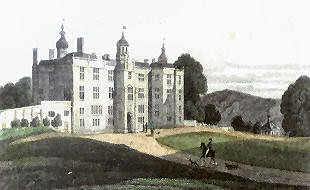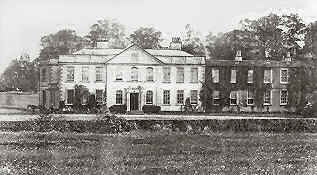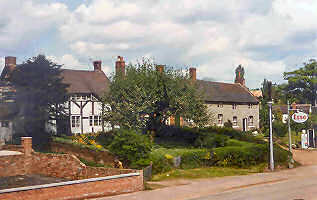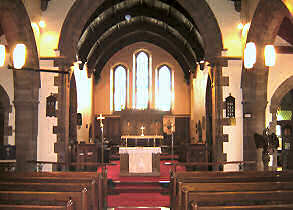Longdon – the name
The name is derived from the Saxon “LANGANDUNE” meaning long hill, located in the old Offlow Hundred. The Bishops of Lichfield held the ancient manor of Longdon. True to its name an ancient rhyme ran: – “The stoutest beggar that goes by the way, cannot beg through Longdon in a summer’s day”. The manor courts for Lichfield and Longdon were held in the old Moot Hall in Lichfield.

In 1546 the Bishop of Lichfield was forced to surrender many of his estates to the Crown, amongst them was the Manor of Longdon and his house at Beaudesert.
The Manor of Longdon subsequently passed to Sir William Paget (later Lord Paget), one of the principal Secretaries of State to Henry VIII. The Manor Court was transferred to Longdon Green. The Longdon Manor included Burntwood, Hammerwich and Cannock Heath. A survey of 1597 recorded the rights to graze for freeholders of Longdon over 800 acres of heathland in Burntwood and Hammerwich. In a muster roll of 1539 Longdon was able to produce 23 able men, some with horse, mostly with either a bow or byll, and produced a rent in 1549 of £78.18s.8d. to Sir William Paget. Longdon, in 1563 was recorded as having 102 households, which grew to 178 by 1665. Early records of Hearth taxes chargeable show principally: – Sir Brian Broughton, William Orme of Hanch Hall and Edward Arblaster of Lysways Hall.

The more modern Parish of Longdon occupies some 4,545 acres, which not only borders the Forest of Mercia (Cannock Chase), but also includes a tract of common land, known as Gentleshaw Common. It contains four settlements, Longdon Village or Brook End, as it is popularly known, Upper Longdon, originally known as Overend, Longdon Green and the separate village and ward of the Parish, Gentleshaw. The population of the Parish is presently 2000 (approx), having remained fairly static over the 19th century around the 1000 level. The increase in population is due mainly to the developments in Brook End and Upper Longdon, (land at Brook End having been sold for building by a naturalist, who later went on to write at great length about the importance of preserving rural villages).
Public houses

There were two pubs in Longdon, the Swan with Two Necks, which still remains today, and the Pig. The Pig was later named the Crown, which after being turned into a residence became the Esso Petrol Station. The Petrol Station finally closed circa 1970 and became a private residence. Brook End had two shops and a forge that has now become the W.I.Hall.
Upper Longdon had two pubs, one “The Gate” on Lower Way, suffered badly due to mining subsidence and was pulled down in 1985. Houses now occupy the site. The remaining pub is the “Chetwynd Arms”. Mining operations from Lea Hall pit caused much damage in Upper Longdon and it was a great relief to the village when the pit closed in 1985.
Longdon Green has a pub called the Red Lion, which is many years old. Longdon contained the seats of several titled families and hence was always a wealthy parish.
Longdon Parish Church

Longdon Parish Church, St. James The Great, dates from the 12th century and stands at the top of a hill overlooking the rest of the village to the north. An avenue of old yew trees leads up to the Church. The nave contains a very fine Norman arch with Saxon zig-zag ornamentation.
John Stoneywell, Benedictine Abbot of Pershore, erected the chapel on the south side of the Church early in the 16th century and was buried there in 1553. (Stoneywell, just south of Longdon Green was owned by the Stoneywell family). Sometime in the 19th century the old oak box pews were removed from the church (reportedly finding their way into local homes as panelling) later the roof of the nave was entirely renewed. Later still the nave and chancel floors were re-laid, the chancel roof re-slated and the altar brought down into the crossing in the body of the church. Plans to remove the pews were rigorously resisted. The church bells were re-hung and a new 6th bell cast in 1999 to mark the year 2000.
Gentleshaw
The name “Gentleshaw” (written as recently in the 1900’s as “Gentle Shaw” or “Gentleshawe”) means the shaw or grove of John Gentyl, who was in the service of the Bishop of Lichfield, Coventry and Chester in the reign of Edward 111. In 1547 Gentleshaw was a “Moiety of 10 acres of land and 10 acres of wood”, but for more than 100 years the name has applied both to the hamlet within the civil Parish of Longdon and the ecclesiastical Parish, which also includes the adjoining village of Cannock Wood, which is within the Cannock Urban District.
The two villages now form a distinct social unit, the Parish Church and village Primary School being in Gentleshaw and other amenities such as a Post Office and Garage (now both closed) being in Cannock Wood.
In layout, the hamlet of Gentleshaw is virtually unchanged since the beginning of the 20th Century, though most of its original redbrick cottages have been extended and refaced. Historically there was a monastery known as “The Abbey at Redmore”, however not a stone remains, though part of the outline of the moat may still be seen. The monastery is thought to have been established between 1135 and 1139, but the monks found the land “too wild for them to tame” and moved to Stoneleigh, in Warwickshire in 1154. It is believed that the building then became a Royal hunting lodge. Certainly, such a lodge existed in the area known as “the King’s house”. King John visited it. Close by is Nun’s well, named after the nuns of the priory at Farewell, a chalybeate well once surrounded by a brick arch said to date from the time of Henry VIII.
The largest house in the area is now Chestall House, parts of which date back three to four hundred years. Once the residence of the Marquis of Anglesea’s agent, it is now a private dwelling.
Gentleshaw Parish Church

The Parish Church, “Christ Church“, built as a chapel ease for the Parish of Longdon in 1837, owes its highly individual appearance to an ambitious project to rebuild the church from end to end. The first part of the project was completed by March 1905. What the visitor sees is, in effect, the west end of the original church (save for the upper half of the tower) and the east end of the new. The result is an interesting contrast in styles. The extension of 1903 replaced this with the present chancel and added a new choir vestry. In addition the organ was re-sited and enlarged. The arches included in this new work are of Penkridge stone. The barrel vaulted roof of the chancel and first bay of the nave forms a striking contrast with the roof at the west end of the nave, which is supported by tie trusses. The stained glass windows, while attractive, are not old. The earliest is the window on the south side depicting the Adoration. This was erected in memory of Alfred Joseph Bradbury. A second window in this aisle depicts the Good Shepherd and is in memory of Enos Bradbury. The east window, which depicts the Ascension, is in memory of the fallen of two world wars and was dedicated, together with the window next to it in memory of Ellen Meachem, in 1946. The most recent is in the north aisle and depicts the Annunciation. This window is in memory of Maurice Hunt, a former member of the choir.
St James’ C of E Primary Primary School, Longdon
St James’ C of E Primary sits in a picturesque village that offers a wealth of history. The school was founded in 1857 and the original school building still stands and is now currently used as The Village Hall.
Gentleshaw Primary School
The village school, now Gentleshaw Primary, was built in 1878 and enlarged in 1882. Previously children attended lessons in a schoolroom attached to the School House, now a residential dwelling in Darlings Lane. Children paid a penny a week, and while payment could be made in kind, such as soap or eggs, the child who brought none at all was immediately sent home. The school consisted of three classrooms, divided by moveable partitions, two little porches and a small back yard. The premises were finally modernised in 1958 with the addition of a hall, kitchen, flush toilets and automatic heating system. To accommodate a rising school population three extra classrooms and additional cloakrooms were added in 1967.
